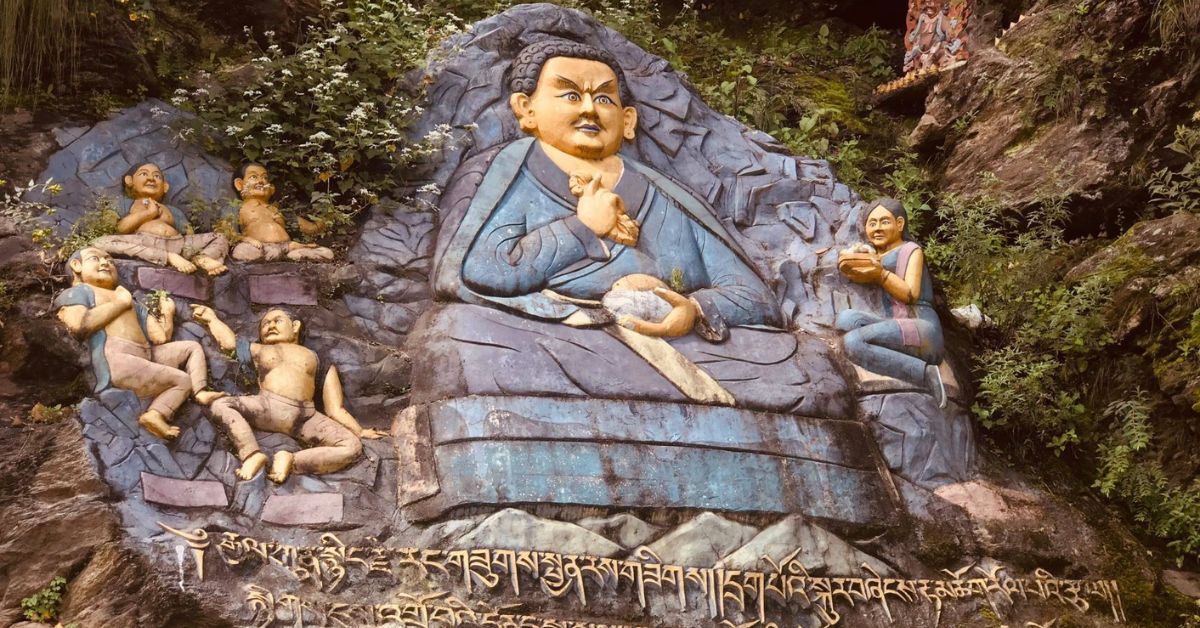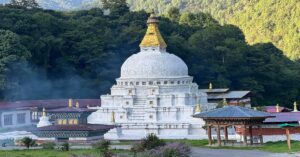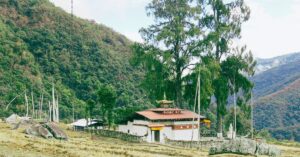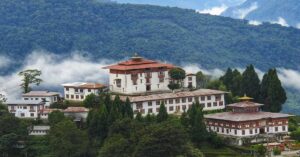Phajo Drugom Zhigpo is the embodiment of Avalokitesvara, who first introduced the Drukpa Kagyu to Bhutan in the 13th century, following the prophecies of Guru Rinpoche and Tsangpa Gyarey. Phajo Drugom Zhigpo came to Bhutan from Tibet in 1224 A.D. to propagate the Drukpa Kagyu in the western region of Bhutan.
In the religious history of Bhutan, he is deeply revered as the pioneer and dynamic Drukpa leader whose life and deeds are intimately linked with the spread of Drukpa Kagyu in Bhutan. Phajo Drugom Zhigpo is also known as Tobdhen Phajo in Bhutan.
There are 17 strongholds of Sacred Sites linked with Phajo Drugom Zhigpo, which are the twelve meditation sites of Phajo entrusted to him by Guru Rinpoche, and five other sites are of the five clans of Phajo Drugom Zhigpo’s descendants. These include Lingzhi Jago Dzong, Taktsang Senge Samdrup Dzong, Tango Choying Dzong, Yangtse Thuwo Dzong, Gomdrak, Thujedrak, Dechen Drak, Tshechu Drak, Tsendong Dowaphu, Langthangphu, Sengyephu, Gawaphu, Hungrelkha, Changangkha, Wachen, Goen Sangmey, and Dodeyna. Among all the Taktsang, also known as Tiger’s Nest, is the most iconic monastery built in Bhutan.
These sacred sites associated with Phajo Drugom Zhigpo and his descendants are part of the Tentative list of Bhutan for inclusion in the World Heritage List.
Let’s discuss Phajo Drugom Zhigpo’s biography here.
The Birth of Phajo Drugom Zhigpo and His Early Years
According to Phajo Drugom Zhigpo’s biography, he is the incarnation of Phagpa Thuje Chempo and Pel Tandin. He was born in 1184 A.D. to Tshongpon Ranzang (Dawa Zangpo) and Palmo Deki in the village of Bapchu in Trashi Yangtse in Dokham, Eastern Tibet. He belongs to the Gya clan. He was the youngest son and named Dondrub Gyaltsen.
At a young age, he had a vision of Guru Tshoki Dorji in his dream. He started his studies under a Nyingma teacher who taught him reading and writing at seven. According to the prophecy granted by Guru, he went to study under Lam Tharpa Lingpa, from whom he received teachings of Sanga Nyingma at the age of 12. He was named Tharpa Gyaltsen. He also received instructions on generating the great thought of enlightenment, teachings on the Maha, Anu, and Ati levels of Tantra, Dzogchen, and empowerment, and teachings on “all the Cycles of Mahākāruṇika”.
Hearing the name of Tsangpa Gyarey
One day, Phajo met a trader from the region of U Tshang while fetching food provisions. He learned of the spiritual reputation of the Lord of the Dharma, Tsangpa Gyare, from a trader of Jang Taklung. Just hearing the name of Tsangpa Gyare generated a deep sense of devotion in him, and tears came to his eyes. Phajo was deeply moved and decided to visit Tsangpa Gyare in Ralung. He asked his teacher for permission to travel to Samye and Lhasa on a pilgrimage. He started his journey once his teacher gave him the last instructions. His trip to the U-Tsang region of Tibet took about a year.
When he reached Lhasa, he enquired about the Lord of the Dharma. Unfortunately, he was told that the master had died three months before. At this news, he immediately lost consciousness. When he regained his senses, he was told about Onre Darma Sengye, a nephew and holder of the teachings of Tsangpa Gyare.
Meeting of Phajo Drugom Zhigpo with Onre Darma Senge
At 33 years of age, Phajo finally reached Ralung, and as instructed by Tsangpa Gyare before his death, Onre Darma Sengye took him as his disciple. Just before he passed away, Tsangpa Gyare Yeshe Dorje, the founder of the Drukpa school, said to his nephew and Regent, Onre Darma Senge:
“A Khampa son from Kham is coming. But he won’t meet me. You look after him. Send him to the southern valley (Bhutan) that has been visited and blessed by Orgyen Padma Jungne. He will be of great service to the Buddha Dharma.”
According to this verbal will of Tsangpa Gyare, Sangye Oenrey also gave Tharpa Gyaltsen comprehensive empowerment of Drukor and the Six Yogas of Naropa. Tharpa Gyaltsen meditated at Jekar and Longdol after absorbing the teachings for almost a year. He “strenuously practiced meditation for three years and fully actualized the realization.” He particularly refined his command of Mahamudra.
Phajo then went back to his master, Onre Darma Sengye. He related his experiences and, impressed by his realization, Onre gave him the name Phajo Druggom Zhigpo, i.e., “Pha or patriarch, the Accomplished Asetic (Zhigpo), the One Meditating on the well-being of the Living Beings” and bestowed on him the complete empowerments and teachings of Rechungpa’s Ear Whispered Transmission of Samvara.
The Prophecy to Visit Bhutan
One day, when Sangye Oenrey was drinking tea, he shared with Drugom Zhigpo from the same cup and conveyed the prophecies of Tsangpa Gyare. He then gave him instructions about his activities in Bhutan. The prophecies read:
“In the future, in all the regions of U
In the dark regions of the southern valley
The teachings will flourish for a long time
A pre-destined disciple from Kham will submit before you
Give him all the teachings and send him south (Bhutan)
He will benefit the Drukpa teachings
Besides, the sun of prosperity will shine in the southern valley
In the future, I will also be born there
And then, the dual tradition of monastic and civil systems
will be turned
Then, I pray that I will meet my disciple there”.
With this prophecy, Sangay Oenrey gave Phajo Drugom Zhigpo a skull full of Duetsi Rilbu, a rosary made of Buddi-citta, a Mani Kabum, and a garment he was wearing. Phajo was then sent to Bhutan.
Phajo Drugom Zhigpo’s Visit to Bhutan
Phajo Drugom Zhigpo arrived in Bhutan in 1224 A.D. at the age of 40, following Sangay Oenrey’s instructions. He crossed the border between Tibet and Bhutan and entered the southern valley via Jomolhari. Aum Jomo, the goddess of Jomolhari, peacefully welcomed him. The local man in that village offered him a bull. Phajo then proceeded upward with the bull.
On the way, Jomo greeted him, and the place became known as sNgon-lung, the Valley of Welcome. The bull guided the way through the glacier, and the place was called Glang La, Bull Pass. On this pass, the self-arisen six-syllable mantra Ma-ni, an utmost clear image of the yogini, and many other manifestations appeared on a huge stone. He then concealed the self-created images in the cliff as treasure and stayed there for one month. The cliff called Srin-phug-brag later came to be known as Jagoe Dzong.
Also Read: Guru Rinpoche in Bhutan: His Visits to Bhutan and Sacred Sites
The prophecy of Guru Rinpoche
From there, he went to Paro Taktsang Senge Samdrup Dzong and meditated in Khandro Palphug for one month. Guru Tshokey Dorje instructed him in a vision that he should meditate in four fortresses, four cliffs, and four caves.
From Taktsang, he returned to Lingzhi Tsedong Phug Gawaphu and stayed for three months. There, he subdued an evil spirit with the head of a snake and the tail of a yak. Four rich persons, each owning a thousand cattle and thus called Tongpen, assembled at Tara Lakha and received empowerment for life from Phajo. As a token for these initiations, they offered Phajo Drugom Zhigpo, all the people and the pastures under their control.
To accomplish the prophecy of Guru Rimpoche in the 12 sacred places, Guru also prophesied that he would have a consort from Chudo of Wang who would be the incarnation of Machig Labdon. Phajo was instructed to go to Gomdra and Wang-Seng-Phug, located above Chizhi Goenpa. Per the prophecy, he went to Gomdra via Tshelung Nye and Thujedrak, meditating and later discovering Drupchhu from the rock.
Also Read: Drupchhu or Holy Spring Waters in Bhutan: Beliefs and Benefits
At Gomdrak, after one and a half months, the pious practice and the successful experience of clear light never seen before appeared constantly to Phajo every day and night.
Now, let us discuss about Phajo Drugom Zhigpo family tree here.
The Birth of First Son, Dampa Sangay, the Second Descendant of Phajo Drugom Zhigpo
Then Phajo Drugom Zhigpo went to the cave of Draphu Sengay Gyeltshen in Wang, Thimphu. When Phajo Drugom Zhigpo was meditating in Draphu Sengay Gyeltshen, many girls from Wang Chudo frequently visited him to pay their respects. Among these girls, the lady Achog, a dakini belonging to the lotus family from Wang Chudo, showed much greater devotion and attended to him with deep reverence.
At that time, Phajo knew through his insight that the great Indian saint Pha Dampa Sangay would be reborn. Realizing the moment to be auspicious, he gave five sacred pills to the lady Achog. After consummating his spiritual union with her to beget his son Dampa, he told her that the incarnation of Pha Dampa Sangay would be born to her a year later. Therefore, it was important for her to maintain unadulterated faith and devotion. Since there would be a possibility of great risk for the child, she needed to keep the forthcoming birth of the venerable incarnate secret.
As instructed by Phajo, an extraordinary son gifted with exceptional intelligence was born to her a year later. He was named Dampa, meaning the best. When Dampa was born, Phajo was staying at Tango Choying Dzong. His mother looked after him with great care till he was 15 years of age. It is said that his growth in one month was more than the growth of any other child in a year.
Also Read: Tango Choying Dzong, where Chenrizig revealed himself as “Wrathful Hayagriva”
The Birth of a Daughter from Dakini Sonam Paldron of Wang Sinmo
Phajo encountered Sonam Paldron, a girl who had the telltale marks of a Dakini, at Chagzam Bridge while he was in Wang Sinmo. Phajo took her as his consort as well since he had been told in a vision that he would meet her. The bridge became known as the “Bridge of the Prophecy,” or Lungten Zampa.
Then they meditated at the cave of Dodeyna, where the Tango monastery stands today. She received all of the Drukpa tradition’s guidance and empowerment from Phajo. During the meditation, Hayagriva gave Phajo instructions in a vision to propagate the Drukpa lineage’s customs by passing on his line through his offspring. Sonam Paldron gave birth to a daughter nine months later.
Leaving his consort and daughter at Dodena, Phajo went to Gawaphu of Thed, Punakha, and meditated for twenty-one days. After that, he stayed in a hermitage of Tshechu Drak for a month conducting Ganacakra of the Four Types of mKha’-’gro-mas, and for three days, a rain of nectar fell from the sky.
The Birth of Four Miraculous Sons from Dakini Sonam Paldron
One day, while he was at the Dechen Draphu in Wangdue Phodrang, he saw the face of the Mandala of Eight Commands and obtained supernatural powers, both the highest and the ordinary. At that time, his rosary’s string broke and the beads scattered in ten directions. While thinking about what it could signify, an immaterial voice from above spoke: “Do not be worried, it is a sign that your teaching will spread all over the Southern Direction. Go back to the place where the prophecy was spoken. Meditate there and protect the living beings by way of your heroic yogic discipline and eliminate the enemies of the Dharma through your magical powers!”
Going back, Phajo finally arrived at his place, Dodedra. Later, Khandro Sonam Paldron gave birth to seven sons. Taking his seven boys to a bridge one day, Phajo tossed them all into the river, calling upon the deities to determine which of his sons were demons and which would protect his family. Three sons drowned, and four remained unharmed. The four sons were Garten, Nima, Wangchuk, and Lama.
The Victory over the Lama Lhakpas
The story of Phajo throwing his sons into the river spread across the country, and Lhakpas, the descendants of the Lhanangpa, became envious and hostile. Before the arrival of Phajo Druggom, Nyoe Gyalwa Lhanangpa, a disciple of Kyobpa Jigten Sumgon, the founder of the Drikung Kagyu, had great influence and controlled a large part of western Bhutan. However, the growing reputation of Phajo began to threaten the spread of his Lhapa teaching brought by Gelwa Lhanangpa. The Lhakpas sent a letter to Phajo saying:
“You cannot spread your teaching without mutual consent, since I have started teaching in this country for the first time. You should either look after the monastery of Jathel Dzong or serve mutually. Else we will have a dispute”.
Dismissing the threat, Phajo replied in writing that Onre Darma Sengye had sent him to propagate the Drukpa lineage’s teachings as per the Tsangpa Gyare’s prophecy. Then the dispute erupted between the Lhapas and Phajo, exchanging forces and power, where the Phajos’ effort made it to succession by overcoming the Lhapas to spread the Drukpa Kagyu. When Noge Gelwa Lhanangpa heard this news, he said to his followers, “The Drukpa Kagyu spread was predestined for the small kingdom, while the rulers of the kingdom would remain from his lineage.”
Phajo started methodically disseminating the Drukpa lineage’s teachings. He exerted significant political and spiritual influence over the rest of Bhutan and solidified the Drukpa lineage teachings as the dominant school in western Bhutan.
Phajo Drugom Zhigpo’s Death at Choying Palace of Tango
Before his death, Phajo gathered all five sons. When all the sons were gathered, he told them the following:
“My sons, who are the incarnations of high noble lineages
My sons, who are sidhis having gained deep insight
My sons, who are the jewels ‘Norbu Rinchen Samphel’
Who assume mortal guises to benefits sentient beings,
Five sons, who resemble the lineages of lion, listen.”
Composing such verses, Phajo Drugom Zhigpo gave his sons advice and instructions regarding the Dharma and how to look after his patrons. He appointed his son, Garten, as the lama and ruler of Dung, Hed, and Dong and as the authority of eastern Bhutan. Nima was appointed as the lam and ruler of Gung and Chang, and as the authority of the frontier territories, while Wangchuk was appointed the lama and ruler of Thed and controller of Wodi. As predestined, Lama became a monk and was asked to be in Paro and Thimphu. Dampa was instructed to replace his father at Tango and look after both the teachings and patrons of Drukpa Kagyu.
He prophesied that, “In the future, the promoters (Zhabdrung Ngawang Namgyal) of the teaching of Durkpa Kagyu would come from Ralung in Tibet and that the descendants of his sons needed to become their patrons and serve them.”
Saying this, Phajo Drugom Zhigpo passed away at his Tango Choying Dzong at age 68 in 1251 A.D. On the fifteenth day of the first lunar month, just as the sun rose, the physical form-body of Phajo Rinpoche dissolved into the Realm of Ultimate Reality.
The Contribution of Phajo Drugom Zhigpo in Bhutan
According to the biography, Phajo traveled extensively in the western part of Bhutan and is credited with establishing at least three major temples, palaces, and hermitages. Among these are the Tango Choeying Dzong, the hermitage of Dodedra situated at the foot of the hillock leading to the present-day Chari Monastic complexes, and the cliff hermitage of Thuji Dra, which is located above the present-day Phajoding Monastery.
The biography of Phajo Drugom Zhigpo also mentions the twelve meditation places entrusted to him by Guru Rinpoche, where he meditated at these sites to fulfill the prophecy of Guru Rinpoche to salvage sentient beings from suffering through the teaching of Drukpa Kagyud.
The Sacred Sites of Phajo Drugom Zhigpo and his Descendants
There are 17 strongholds of Sacred Sites linked with Phajo Drugom Zhigpo, which are the twelve meditation sites of Phajo entrusted to him by Guru Rinpoche, and five other sites are of the five clans of Phajo Drugom Zhigpo’s descendants. These include Lingzhi Jago Dzong, Taktsang Senge Samdrup Dzong, Tango Choying Dzong, Yangtse Thuwo Dzong, Gomdrak, Thujedrak, Dechen Drak, Tshechu Drak, Tsendong Dowaphu, Langthangphu, Sengyephu, Gawaphu, Hungrelkha, Changangkha Lhakhang, Wachen, Goen Sangmey, and Dodeyna. Among all the Taktsang, also known as Tiger’s Nest, is the most iconic monastery built in Bhutan.
These sacred sites associated with Phajo Drugom Zhigpo and his descendants are part of the Tentative list of Bhutan for inclusion in the World Heritage List.
The Twelve Meditation Sites of Phajo Drugom Zhigpo in Bhutan
When Phajo Drugom Zhigpo was meditating in Paro Taktsang for a month, in a vision, Guru Rinpoche instructed him to travel throughout the country and meditate at twelve places. These places include four fortresses (Dzongs), four cliffs (Drags), and four caves (Phugs) scattered within Thimphu, Paro, Punakha, and Gasa districts.
The Twelve Sacred Sites are:
Four Dzongs (Fortresses)
- Taktsang Sengye Samdrup Dzong,
- Tango Choying Dzong,
- Lingzhi Jagoe Dzong and
- Yangtse Thuwo Dzong.
Four Draks (Cliffs)
- Gom Drak, located above Nangkor in Chang, Paro,
- Thuje Drak, known as Puemodraka, is located above Phajoding Monastery,
- Tsechu Drak, known before as Goen Dutsidra and
- Dechen Drak or Sha Dechen Draphu, located in Khothangphu.
Also Read: The 4 Sacred Cliffs of Guru Rinpoche Entrusted to Phajo Drugom Zhigpo
Four Phugs (Caves)
- Tsedong Dowaphug in Lingzhi,
- Gawa Phug, Gawaphu in Thed Kabisa, Punakha,
- Langthang Phug in Wangdue and
- Draphu Sengay Gyeltshen/Sangayphu in Dagala.
The influence of the Drukpa-Kagyu tradition in Bhutan gradually gained strength by prevailing over groups of other Buddhist traditions from these centers. Later in the 17th century, these sites took significant roles, becoming strategic footholds during the consolidation and unification of the country under the rule of Zhabdrung Ngawang Namgyal.
The Five Sacred Sites of the Five Clans of Phajo Drugom Zhigpo’s Descendants
The other five sites had been the regional centers of the five clans of Phajo Drugom Zhigpo’s descendants who controlled different regions: Hungrelkha in Paro, Dodeyna and Changangkha in Thimphu, Wachen in Wangduephodrang, and Goen Sangmey in Punakha.
Many of these sites have greatly transformed their physical state and functions, reflecting the dynamism of Western Bhutan’s socio-political changes. For instance, the main dzong of Hungrelkha was replaced by a magnificent fortress of Zhabdrung Ngawang Namgyal, and only a few related important sites remain, including a shrine of the deity called Hungrel Gyem Lhakhang. At the same time, Wache Dzong, a medieval Dzong in ruin, was renovated and consecrated recently. Changangkha Lhakhang is an important temple of a protective deity in the region and is frequented by the inhabitants of Thimphu.
You can visit all the pilgrimage sites associated with Phajo Drugom Zhigpo with the Bhutan Pilgrimage Package.
Frequently Asked Questions
Where did the Druk Kagyu come from in Bhutan?
The Drukpa Kagyu was brought to Bhutan from Tibet.
Why did Phajo Drugom Zhigpo come to Bhutan?
Phajo Drugom Zhigpo came to Bhutan to propagate the Drukpa-Kagyud following the prophecies given by Guru Rinpoche and Tsangpa Gyarey.
Who prophesied the arrival of Phajo Drugom Zhigpo to Bhutan?
Phajo Drugom Zhigpo was prophesied to arrive in Bhutan by Guru Padmasambhava and the Drukpa Kagyu founder Choeje Tsangpa Gyarey.
Who established the Drukpa Kagyu tradition in Bhutan?
While Phajo Drugom Zhigpo first introduced Drukpa Kagyu to Bhutan in the 13th century, Zhabdrung Ngawang Namgyal established it as the state religion in the 17th century.
What are the contributions of Phajo Drugom Zhigpo in Bhutan?
The significant contributions made to Bhutan by Phajo Drugom Zhigpo in the 13th century are:
- Introduction of Drukpa Kagyu School in Bhutan;
- Establishment of Temples and Hermitages;
- Twelve Meditation Sites.
Enjoyed reading this blog?




